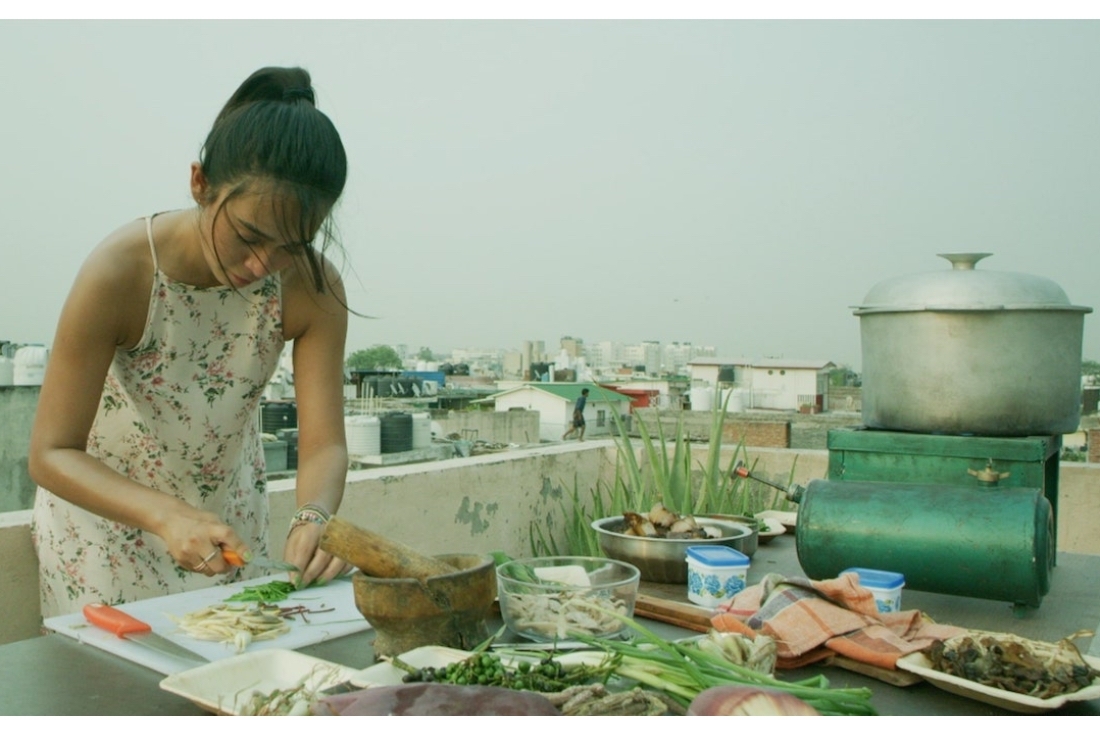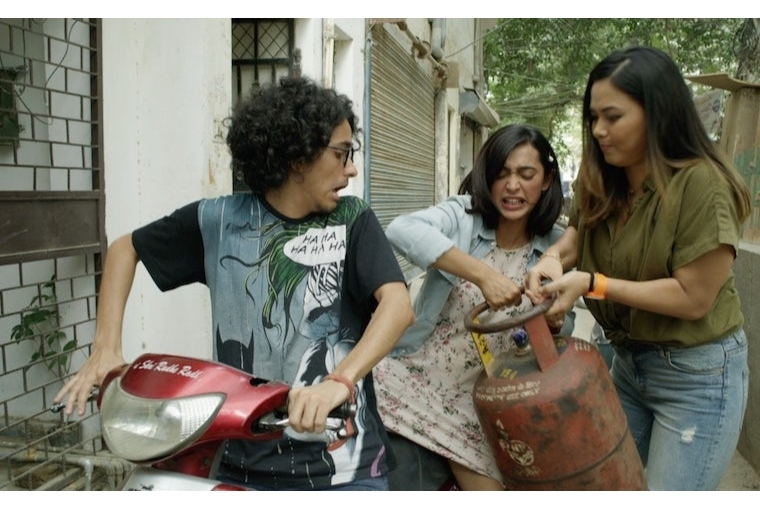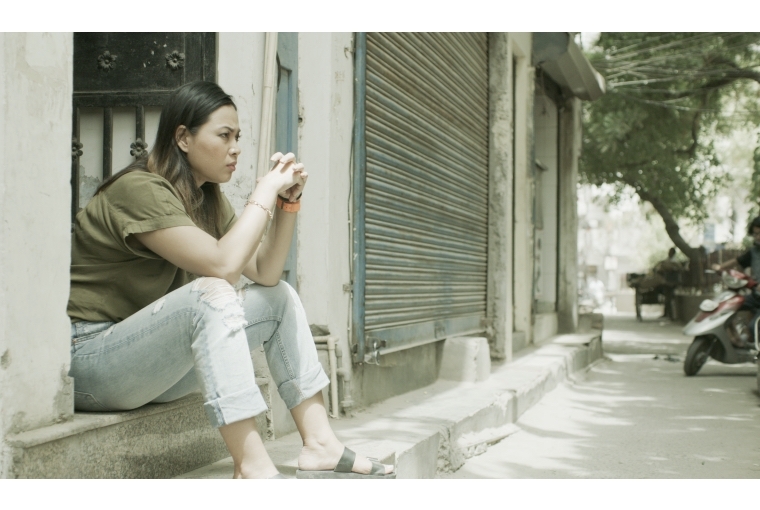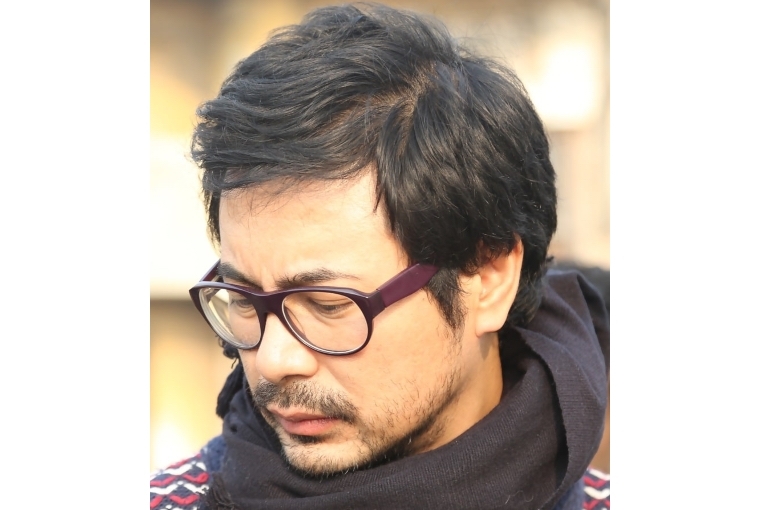
A film still

A film still
A filmmaker from Nagaland, Nicholas Kharkongor was born in the eighties, in a very small town called Mokokchung. At the time, there was no TV, only Doordarshan, newspapers came a day late and cinema simply didn’t exist. The latter, however, made its way in his life when he moved to Delhi for a project and tried his hand at theatre. He fell in love with the intimate experience of it. One thing led to another and Nicholas began writing and directing plays for a living.
12 years and a meeting with Rajat Kapoor later, in 2017, he was ready with the draft of his debut film, Mantra. It was made on a shoestring budget but actors like Rajat, Kalki Koechlin and Adil Hussain hopped on because of the incredible script. Now, three years later, Nicholas is ready to tell the world a story which is very close to his heart. Axone, now streaming on Netflix, is a film that focuses on migrant lives. A satirical comedy at its core, it explores the heavy subject of racism against people from the North-East. We connected with the filmmaker to understand how challenging it was to make this film and the pain of being the ‘other’ in your own country.
Tell us a little bit about yourself and your love for the North-East?
I'm essentially a boy from the hills — a tribal boy in my case. I just love walking in the forest, climbing up the hills. I feel very happy getting my hands and feet dirty, and breathing clean air, as opposed to the other way around in the city. Also the North-East is bucolic. Simple and untouched — it's home. I absolutely love the food and hence a film like Axone was made by me. The other thing about the North-East is its diversity. It’s this very small piece of land, but within that small piece of land, there exists the greatest variety, and that's because topographically and geographically, the terrain is difficult. So what happened over the centuries was that people just lived in one hill, which was completely inaccessible, and just across, another hill belonged to another community. They were in complete isolation because it was just not possible to move freely from one part to the other.
That's how a lot of these different tribes were born, with their own separate languages. India by varying accounts has around 400 languages to maybe 600 languages. A third of these languages come from the North-East. It’s one of the things that we attempt to do even in Axone. In a scene, which we call the ‘babel’ scene, a bunch of these friends whom, someone not from North-East, would assume were all from one place and therefore spoke one language, thinking there was great homogeneity. Yet in that scene, you suddenly see each one of them speak different languages. There are so many languages, customs and rituals in North-East that when you move a short distance, you feel like you're in a totally different world, especially if the religion is different. Remember that there are a lot of indigenous religions as well. This is something I love about the North-East.
What led you to the making of Axone?
I am from the North-East and have lived outside of it for a very long time. I really wanted to, therefore, make a film about the North-Eastern experience of living in the big city. I take the responsibility of being an artist very seriously. So, it was always there in my mind. I just needed to get to a point where I was in a position to be able to write and direct a film — in other words, find production money for it. The film was picked up by Yoodlee Films and that also happened because firstly, they liked the script, and secondly, because the head of ULI films, Siddhartha Anand Kumar is an old friend of mine from the theatre. He knew me quite well, believed in me and thought I could pull this off which is why we got the money to make it. Having said that, it was a risk that Yoodlee was taking for sure, and knowing that, we worked on a small budget.
Was casting challenging considering Bollywood rarely casts North-Eastern actors?
Yes it was. I have worked as a director for a very long time and therefore, have interacted with actors all my life. They're my lifeline. Unfortunately when I moved to Bombay I discovered that there aren't many North-Eastern actors and that was something that really troubled me. I really wanted to be able to change that in some ways. And it's not difficult to cast North-Eastern actors. This is a conversation I have all the time with people in the industry — in fashion today you see a lot of North-Eastern faces, even in news media to a small extent, but we just don't see that in television and film. It makes no sense to me whatsoever, especially now with so much diversity of work available in these fields with the rise of web series space and online platforms. If you're setting the film in a village, I can understand, but if you're setting the film in Delhi or Bombay, there is no reason why you can't use a North-Eastern person. North-Easterners are a part of the city everywhere you go.
As for the process, we thought it would be easy to find North-Eastern actors in Delhi, where the film is set. So we started looking for people and realised that the people who come to Delhi from the North-East are all either students who are in Delhi University, or working. Hence, it's not easy for them to just take off for three months. It was thus a long search with my casting director, an old friend of mine from the theatre, Dilip Shanker, who has worked for a few international films like Life of Pi. Because we couldn’t find the right people, pre-production got unnecessarily extended. We just couldn't get enough people. We ended up putting up posters everywhere, in markets and so on. Even that didn't work, and then we went to all the tribes. However, finally, I did find the right people, even though the entire process took about six months. In this case, casting was very difficult to tackle.
How challenging was it to maintain the balance between making a comedy film yet exploring themes like racism and migration?
Very early on, when I had decided to make a film about the North-East, I had decided that it would have to be a comedy because if I played the racism card in a dark and serious way, I would’ve only a few takers. Not just in terms of money, but in terms of eyeballs as well. One can talk about death in a very serious way, or you can make a black comedy on it instead, which is equally valid. So I decided to go with comedy for all these reasons and it was reasonably challenging to do that, because while I wanted to make it funny, I also wanted to look at the very serious nature of racism. In the film there is a scene where a North-Eastern girl is attacked. Later, we realise that her boyfriend himself went through a very violent attack by some goons. It is based loosely on what happened to Nido Tanya, in 2014, when a boy who had blonde hair in Lajpat Nagar, Delhi was made fun of. They attacked him and it eventually led to his death. So it was a difficult thing to be able to balance that serious side. Of course, the comic elements play out in scenes where they're trying to cook, et cetera.

A film still
Do you think arthouse and indie cinema still finds it difficult to succeed, or do you think with platforms like Netflix and Amazon, such films are finally finding their path?
I think it will always be difficult to make indie films, that’s never going to change. I remember when multiplexes came in the early two thousands, everyone was like it is a big platform where indie films can be showcased. However, the big films captured it as their own space. Now with Netflix, Amazon and other OTTs, it's true that again, there's a bigger playing field, but it still means that you're competing with the big films. So you're always the lesser one. You may not get the right kind of money, or you may not get picked up in the first place, and things like that.
How difficult was it to get the funding?
I was convinced it was going to be very difficult in my head when I wrote the script because it was a film about North-Eastern life with a cast of 75% North-Easterners. Initially, I did try to meet North-Eastern funders but it is difficult to explain cinema to these people as they don't know much about films. Then I also tried reaching out to state governments because I said here's a problem that concerns all the North-Eastern states as everyone in Delhi or Bangalore is on the receiving end of racism. Therefore, maybe the government might be interested in helping with some funding. However, every state just wanted to talk about their own state and not the other sister states. It was quite crazy and I was so frustrated. Then I went back to Bombay and started reaching out to people. Luckily for me, my friend, Siddharth Anand Kumar, who heads Yoodlee Films, helped me out because he really liked the script. He was ready to take a risk.

A film still
What do you want the audience to take away from the film?
Well, the most important that I was the audience to take away from the film is that racism exists in this country and people from the North East, living out the Northeast bear the brunt of it. But this film is not just about racism, it's ultimately about prejudices. All of us have prejudices, whether related to gender, sexual orientation, skin colour, class, caste etc. Racism is just one form of prejudice. So the film also talks about prejudices that people from the North East have among themselves. Of course, that's human nature and in no way does their prejudices amongst themselves justify the racist attack on them.
Lastly, what’s next?
I've written this epic film, which is set in Nagaland and tells its history of over 50 years. Nagaland has had a very checkered history, from calling for independence from the state of India in 1947 itself, to the fight between the army and the underground, thereafter the main underground groups splintered into a couple of opposing groups and then the problem of drug abuse. Remember that it's close to Burma, Laos and Thailand, and there's this golden triangle, straddling these three countries where 80% of the opium is manufactured. So a lot of drugs come into the North-East very easily.
There's also another film set in Shillong, which I haven't written but have the idea of. I'd love to make it as well, but it requires funding. I also want to work with my family of active friends in Delhi and Bombay, from Rajat to Vinay and Kalki. Obviously, I can’t make North-Eastern films and cast them, as it's unlikely that they will get important roles. However, I still want to be able to make films from Bombay. So let's see where that goes. Right now, nothing concrete. I don't know what I'm doing next for certain.
Text Hansika Lohani Mehtani

Nicholas Khargonkor